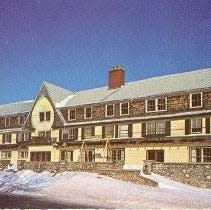Step Back in Time: Waters was a former home of a big barn and famous bottle fence

Bill Granlund wrote this account of the Otsego County community of Waters.
GAYLORD — Waters was established in 1876 as the Bradford Lake settlement. In 1885 it was moved and renamed Waters, the name apparently coming from the number of lakes in the area.
Its early history revolved around the logging industry. Mr. James F. Allen, who settled in the village in 1899, was my major source of information concerning the town. By 1899 Waters consisted of around 100 homes, a general store, an office for the Michigan Central Railroad, and two sawmills.
The mills were named Band and Resaw, and Circular and Gang, with 22 saws in operation. A large planning mill, with 10 planer stickers was located in the area. The major employer was the Stephens Lumber Company which had mills, logging operations and 18 miles of railroad track; with two locomotives.
The lumberyard held large amounts of lumber and was extremely flammable. In July 1910 the yard caught fire, destroying 27 million board feet of hardwood, pine and hemlock. By November of the same year about 9 million feet of lumber had been replaced.
Social activities in the village included card parties and dances in the town hall. A baseball team was organized and they played teams from other small area towns. The team was an important part of the town’s image. Tennis courts were built in the village and hunting and fishing were important recreational activities.
The village was situated on what was later the airport area. The village disappeared when the lumber resources were depleted.
The major employer was the Henry Stephens family. Three male Stephens were involved in the lumber business which was founded by Henry Stephens. Stephens was the first to purchase land from David Ward in the Otsego County area.
Stephens expanded his lumber interests, doing quite well, and established the family fortune. His son, Henry Stephens II, continued to expand his father’s business in the area until his death in 1910. His son, Henry (Tom) Stephens III, became involved in the family business and spent much of the family fortune.
Tom Stephens was a controversial figure and many interesting stories were circulated concerning his activities. He was responsible for building the bottle fence in Waters, which was featured in Ripley’s Believe it or Not, and listed on the National Historic Register. The fence was constructed out of empty bottles which, for the most part, had once contained alcoholic beverages.
The bottles had been gathered by youngsters in town and sold to Stephens for the wall. There is no doubt Tom contributed many of the bottles from his private stock, at least according to early residents. It is unfortunate the fence has been destroyed. Some have noted a contributing factor was a rumor that Tom had hidden money in one of the bottles.
Tom is credited with having built the largest barn in Michigan in 1914. The main barn was 165 feet long by 45 feet wide and it was 75 feet from the basement floor to the peak of the roof. Extending from either end of the main barn was a wing of 64 feet long and 36 feet wide. It had one silo with a 125 ton capacity and a second silo was planned. It was capped with a cupola and a flag pole which flew the pennant of the Otsego baseball team; another of Tom’s projects. The barn later became the Heart Lake Club, then the Waters Inn. Many fine receptions and parties were held there. It burned to the ground in the early 1970s.
Mr. Stephens wrote two books reflecting on his travels to South America, and he later became a bar owner in Tijuana. He spent the family fortune and died with few assets. He was indeed one of the more controversial individuals in the county.
The Stephens Lumber Company’s interests were sold to the Helper Brothers from Bay City in 1916. This drew to an end another phase of industry in Otsego County. The area’s lumbering gave way to farming and the tourist industry in the southern part of the county.
The Bay City Times contained the following concerning the sale: “Helper Brothers of Bay City have purchased from the Stephens Lumber Company the town of Waters, located on the Mackinaw division of the Michigan Central Railroad in Otsego County, together with everything there is in the place, including two saw mills, a planing mill, 10 or 12 miles of railroad, four locomotives, about 75 flat cars, over two miles of tramways, electric light plant, a water works system, and the work of dismantling the lumbering town will be started at once. Immediately following the purchase Helper Brothers resold all of the buildings to John Kantzler and Sons of this city.”
The store, office, and residence buildings were not included in the sale. A considerable amount of company business had yet to be settled and these buildings were needed for that purpose. The end of a ready supply of timber had taken Waters the way of other area lumbering towns, such as Deward and Haakwood
This article originally appeared on The Petoskey News-Review: Step Back in Time: Waters was a former home of a big barn and famous bottle fence
